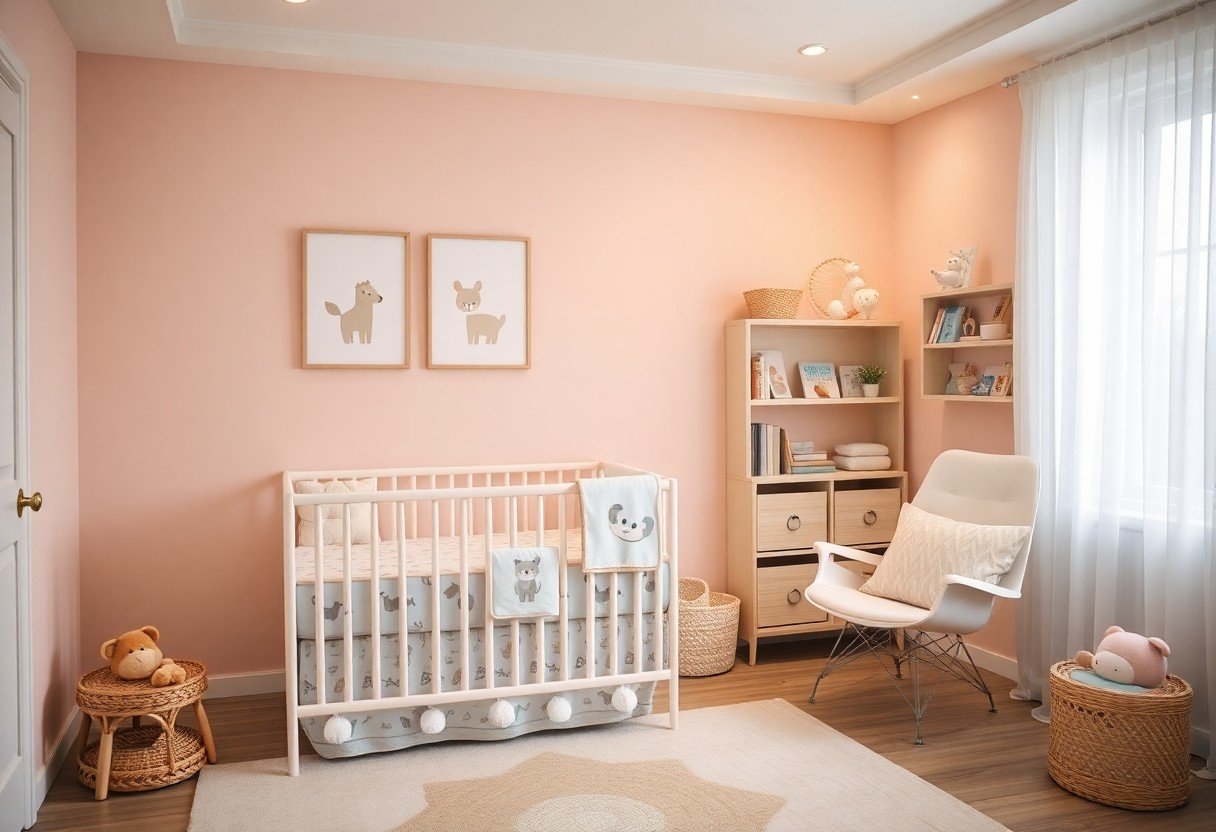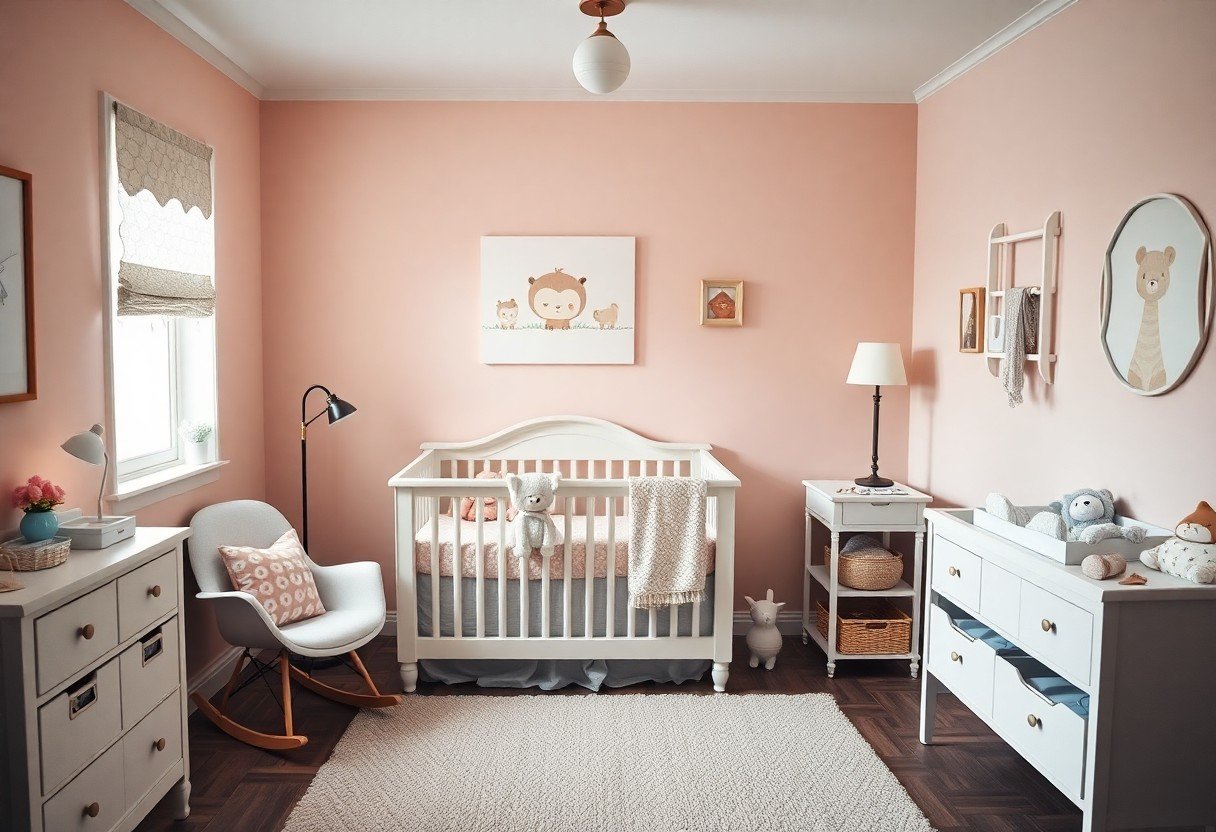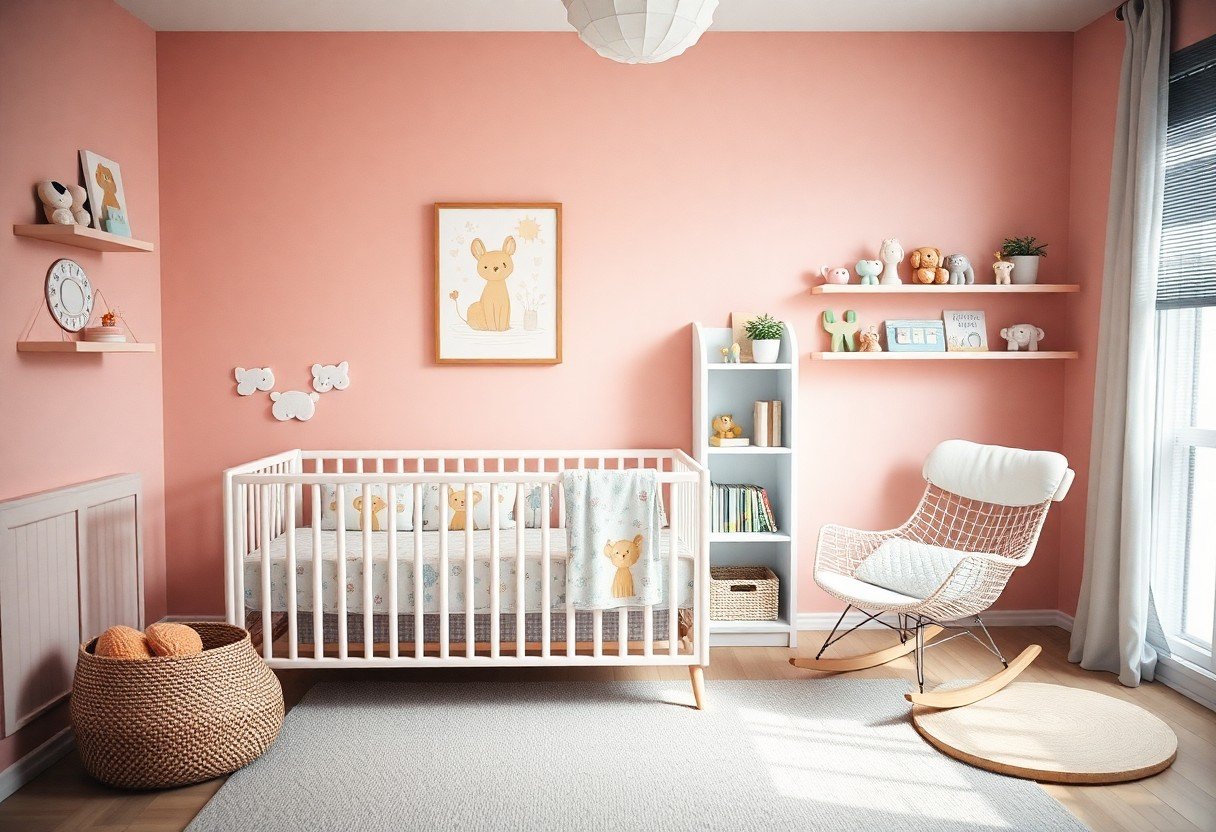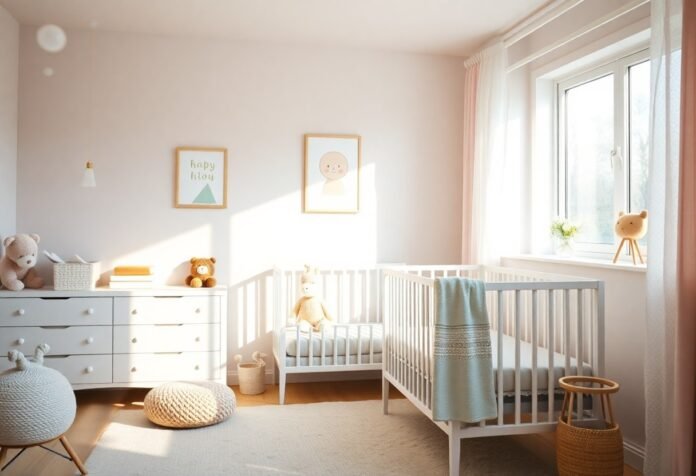Baby Room Decoration Ideas: Most parents want to create a safe and inviting space for their newborn, and in 2025, you have exciting new trends to explore. Your baby’s room should blend comfort with style, incorporating eco-friendly materials and innovative storage solutions to keep everything organized. You’ll find that choosing calming color palettes and multifunctional furniture not only enhances the room’s aesthetic but also supports your baby’s development. Staying informed about non-toxic décor options will help you avoid harmful substances, ensuring your child’s environment stays healthy and nurturing.
Key Takeaways:
- Incorporate soft, pastel color schemes combined with natural textures to create a calm and welcoming environment for the baby.
- Focus on multifunctional furniture and storage solutions to maximize space and maintain organization in the nursery.
- Use themed decor elements such as nature-inspired motifs, whimsical patterns, or minimalist designs to reflect personal style while promoting a soothing atmosphere.

Designing for Comfort and Safety
Creating a nursery that balances both comfort and safety lays the foundation for a nurturing environment where your baby can thrive. Prioritize soft, breathable fabrics such as organic cotton for bedding and curtains, which not only enhance coziness but also minimize allergen exposure. Incorporate adjustable lighting solutions like dimmable LEDs or warm nightlights to support your baby’s natural sleep cycle while keeping the room inviting. Additionally, integrating natural elements such as a small indoor plant (safe for children) can improve air quality without sacrificing aesthetics. Your choices should support a space that feels both serene and secure.
Safety enhancements dovetail with comfort to provide peace of mind. Pay close attention to window treatments—opt for cordless blinds to eliminate strangulation hazards. Rug placement should consider slip resistance while keeping the floor comfortable for crawling or first steps. Architecturally, installing outlet covers and corner guards on furniture ensures that daily exploration happens within a secure boundary. Each detail you select contributes to a setting where your little one can grow safely while feeling completely at ease.
Prioritizing Ergonomics in Nursery Furniture
Ergonomic nursery furniture not only benefits your baby but significantly enhances your comfort during caregiving tasks. Choose rocking chairs or gliders with lumbar support and adjustable features to reduce strain during late-night feeding or soothing sessions. A changing table at your waist height can prevent back pain and improve efficiency. The incorporation of modular furniture systems lets you adapt the nursery as your child grows—for instance, convertible cribs that transition into toddler beds or desks.
Ensure the mattress you select supports healthy spinal development by opting for firm, yet comfortable, designs certified by pediatric health standards. Storage solutions within furniture pieces keep necessities organized and within arm’s reach to limit bending or stretching. This thoughtful ergonomic approach helps maintain your physical well-being, enabling sustained attention and care without discomfort.
Childproofing Essentials for New Parents
Childproofing your nursery involves a strategic approach to eliminate hazards that can emerge as your baby becomes more mobile. Anchor heavy furniture like dressers and bookshelves securely to walls to prevent tipping. Installing safety gates at doorways controls access while safeguarding your baby’s exploration boundaries. Socket covers and switch guards are simple devices that prevent accidental shocks, particularly important as toddlers start to reach and grasp. Cabinet locks keep harmful substances and small objects safely out of reach.
Focus on materials and placement when selecting your nursery decor and toys to avoid choking hazards or toxic components. Keep electrical cords tucked away and use cordless window treatments to eliminate strangulation risks. Despite a well-designed space, active supervision remains the strongest safeguard, enhanced by baby monitors equipped with motion and sound sensors for peace of mind during naps or nighttime. By systematically addressing these elements, you’re creating a nursery where safety is seamlessly integrated into every aspect.
Additional insights into childproofing reveal that some modern innovations can further protect your child—pressure-sensitive floor mats can alert you if your baby crawls into off-limits areas, and smart locks can prevent older siblings from opening doors to dangerous rooms. Reviews of these technologies show a reduction in common household injuries among young children by up to 30%. Integrating such tools provides an extra layer of protection, letting you focus more on bonding and less on constant hazard checks.

Trending Color Palettes and Aesthetic Themes
Current Color Trends Influencing Baby Rooms
Soft, muted tones continue to dominate baby room color palettes, with shades like dusty rose, sage green, and warm beige leading the way. These colors create a serene atmosphere that fosters relaxation and calm, which is especially beneficial for a newborn’s sleep patterns. In contrast, bursts of vibrant colors such as mustard yellow, teal, and coral are being used strategically to add a playful touch without overwhelming the space. These bold tones often appear in accent walls or select pieces of furniture, striking a perfect balance between soothing and stimulating.
You may also notice that gender-neutral palettes are increasingly preferred, focusing on earthy and pastel hues that are versatile and timeless. This approach not only enhances longevity by accommodating future children but also allows you to experiment with layered textures and varied finishes to keep the aesthetic fresh and engaging.
The Role of Accents: Patterns, Textures, and Finishes
In 2025, incorporating accents through patterns, textures, and finishes plays a pivotal role in elevating your baby’s room from simple to spectacular. Textural elements such as knitted blankets, velvet cushions, and woven baskets enrich the sensory experience, creating a cozy environment that appeals to both you and your baby. Patterns, whether on wallpaper, rugs, or curtains, often lean toward organic shapes and nature-inspired motifs, echoing the calming color trends and contributing to a harmonious visual flow.
Finish selections like matte paints for walls combined with glossy or metallic finishes on fixtures and décor add dimension and subtle contrast without clashing with the overall softness of the space. These layers of detail are what turn a nursery into a personalized sanctuary where every item feels carefully chosen to complement the room’s theme.
By thoughtfully combining patterns inspired by flora and fauna with tactile fabrics and complementary finishes, you create a dynamic yet gentle setting. For example, pairing a rug with a leaf motif alongside soft velvet upholstery and brass knobs on dressers can embed a sense of warmth and sophistication that grows with your child’s evolving tastes.
Innovative Storage Solutions for Small Spaces
Maximizing storage in a baby room without compromising on style or accessibility requires inventive approaches tailor-made for compact areas. Choosing pieces that serve multiple purposes can dramatically reduce clutter and create a seamless flow within the room. For instance, opting for a crib with built-in drawers underneath not only frees up floor space but also provides a convenient spot to store blankets and diapers. Such integrated solutions ensure that every inch of your nursery works hard for you, keeping imperative items within arm’s reach while maintaining a tidy environment.
Beyond furniture, smart organizational tools like stackable bins labeled by category can help you quickly locate clothing or toys, streamlining your daily routine. Utilizing hidden storage behind artwork or under changing tables can also add an unexpected layer of functionality, transforming small spaces into highly efficient and adaptable nurseries. These strategies address the common challenge of limited square footage, allowing you to focus on creating a soothing atmosphere for your baby without sacrifice.
Multifunctional Furniture for Maximum Efficiency
When space is at a premium, multifunctional furniture becomes a game-changer. Consider a convertible crib that adapts as your baby grows, transitioning into a toddler bed or even a daybed, ensuring years of use from a single investment. Some models incorporate built-in bookcases or shelves on the headboard, making it easy to keep bedtime stories and toys within easy reach. This kind of furniture not only saves space but also provides a consistent style that evolves with your child’s needs.
A changing table combined with a dresser can also reduce the bulk of having two separate pieces. By stacking drawers beneath the changing surface, you create a dedicated spot for diapers, wipes, and clothes, while keeping everything organized and accessible. Furniture with wheels adds an extra layer of adaptability, allowing you to reposition your nursery setup quickly as your baby grows or as you update the room’s décor.
Creative Use of Vertical Space
Vertical storage strategies can radically enhance your baby room’s accessibility and aesthetic, especially when floor area is limited. Installing wall-mounted shelves above the crib or changing table offers storage without sacrificing precious ground space. These shelves can hold decorative items alongside functional supplies, blending practicality with charm. Pegboards and hanging organizers encourage you to customize and rotate storage options as your baby’s needs evolve.
Utilizing the full height of walls also allows for the integration of tall, narrow storage units that take up minimal floor space but provide ample room for books, toys, and clothing. Floating cubes or wall pockets can be strategically placed at various heights, fostering an engaging environment for your child while optimizing storage. This approach taps into often-overlooked vertical zones, transforming them into versatile storage assets.
Applying vertical storage effectively involves balancing safety and accessibility—ensure that heavier items are stored lower and that all wall fixtures are securely anchored to prevent accidents. Thoughtful placement of vertical storage not only makes the most of your room’s dimensions but also encourages organization and visual interest, keeping the nursery both functional and inviting.

Personalization Through DIY Decor
Personalizing your baby’s room brings a distinctive charm that off-the-shelf decorations can rarely match. DIY decor lets you infuse the nursery with elements that carry sentimental value or reflect your unique style. Incorporate handmade garlands, custom-painted wall art, or even repurposed family textiles to elevate the space beyond basic nurseries trends. The creative process itself becomes a meaningful part of preparing the environment for your newborn, making it more than just a room but a heartfelt welcome.
Exploring ideas on platforms like Baby Nursery Decoration Trends | 2025 provides inspiration for blending current design movements with your personal touches. You might choose to integrate natural materials with colorful yarn crafts or experiment with stencil patterns to create a bespoke mural. Each customized element contributes to a nurturing atmosphere tailored specifically for your child’s needs and your aesthetic preferences.
Unique Art and Craft Ideas to Make it Special
You can transform simple materials into stunning nursery art that feels personal and timeless. Consider making a series of framed, hand-painted animal motifs that tell a story or represent shared family interests. Alternatively, fabric wall hangings with embroidered names or birth details offer a tactile and cozy dimension to the room’s decor. Experimenting with different mediums — like watercolor, chalk pastels, or mixed-media collage — allows you to craft pieces that are both visually engaging and meaningful.
Adding three-dimensional crafts such as paper flower arrangements or soft felt mobiles not only sparks visual interest but also introduces gentle textures for your baby to explore as they grow. These projects also provide an opportunity to involve siblings or relatives in the nursery’s creation, enhancing the collective excitement and emotional investment surrounding your newest family member.
Incorporating Family Heritage and Culture in Design
Embedding elements of your family heritage and culture into the nursery design can create a profound sense of identity and continuity from the earliest days. Employ traditional textiles, patterns, or color palettes that resonate with your ancestry, or display handcrafted heirlooms and photographs as focal points on the walls or shelves. These touches serve both as decorative features and as subtle storytelling devices, helping your child to connect visually with their background as they grow.
To weave in cultural narratives effectively, select motifs and materials significant to your lineage—perhaps a woven basket from a grandparent’s region or iconic symbols depicted in folk art. Such personalized decor makes the nursery a warm repository of family history, weaving your ancestral story into the environment where your baby begins life’s journey.
Further exploring how cultural symbols can be integrated into your nursery design reveals not just aesthetic enhancement but deep relational meaning. By merging contemporary decor trends with traditional artistry and practices, you create a space that honors the past while nurturing your baby’s future. This approach fosters an appreciation for heritage alongside comfort and style, setting your nursery apart in meaningful ways.
Tech-Savvy Baby Rooms: Smart Solutions
The Rise of IoT Devices in Nursery Design
You can transform your baby’s room into a high-tech haven by integrating IoT devices that simplify daily caregiving tasks. Smart baby monitors now come equipped with AI-powered features such as real-time sleep tracking, breathing and movement sensors, and even temperature-controlled soothing sounds that adapt to your child’s needs. These devices not only help you keep watch effortlessly but provide detailed insights through apps, allowing you to make data-driven decisions about your baby’s comfort and health. For instance, the latest smart cribs adjust rocking motions and ambient lighting based on your infant’s sleep cycles, automating what traditionally required constant parental intervention.
Security takes a front seat with encrypted Wi-Fi connectivity, ensuring your baby’s room stays private while you remotely manage devices like smart thermostats and humidifiers. IoT advancements also extend to multifunctional furniture that syncs with your smartphone, offering nightlight controls and automated blackout curtains to create the perfect sleep environment. Beyond gadgets, you can explore 900+ Best Gender Neutral Nursery Ideas in 2025 for inspiration, embedding technology seamlessly within a stylish, inclusive space that grows alongside your baby.
Balancing Technology with Nature: A Modern Approach
Incorporating natural elements alongside smart devices creates a serene environment that supports your baby’s sensory development. Wood-paneled walls, organic cotton bedding, and a curated selection of indoor plants paired with discreet technology like automated diffusers or soft, programmable lighting mimic natural rhythms while ensuring comfort. Leveraging technology to complement, rather than overpower, natural materials helps maintain an atmosphere that feels warm and nurturing while still being functional. This fusion of tech and nature addresses both your desire for efficiency and your baby’s need for calm stimuli.
You might find that combining voice-activated devices with nature-inspired acoustics—such as gentle water sounds or forest ambiance—helps regulate mood and sleep, offering a holistic sensory experience. Selecting smart devices with user-friendly interfaces and minimal visual bulk enables the room to retain a clean aesthetic, allowing natural textures and colors to remain the focal point. And engaging with sustainable tech options reinforces your commitment to creating an eco-conscious nursery that supports healthy living from the very start.
Further enriching your space means carefully customizing the technology to respond to natural cues—consider smart blinds that shift with sunlight patterns or temperature sensors that adjust heating based on room humidity. This thoughtful integration reduces sensory overload, making the nursery a peaceful retreat for both you and your baby. Ultimately, finding harmony between advanced tech and organic elements ensures a well-rounded environment optimized for growth, comfort, and ease of care.
Conclusion
Ultimately, when planning your baby room decoration ideas in 2025, focusing on a blend of functionality, safety, and aesthetic appeal will create a nurturing environment for your little one. You have the opportunity to incorporate modern trends like sustainable materials, soft pastel colors, and multifunctional furniture that grow with your child. By considering your space, lifestyle, and personal style, you can design a room that not only meets your baby’s needs but also brings you joy and comfort during those precious early years.
As you bring your vision to life, think about how each element can contribute to a calming and stimulating space for your baby. From gentle lighting and playful wall art to practical storage solutions, every detail matters in shaping a welcoming nursery. Embracing these baby room decoration ideas allows you to create a personalized sanctuary, ensuring that your child’s first environment is as special and unique as they are.
FAQ
Q: What are some popular color themes for baby room decoration in 2025?
A: In 2025, popular color themes for baby rooms emphasize soft, soothing palettes with a modern twist. Neutral tones like beige, soft gray, and off-white are commonly used as base colors, complemented by pastel shades such as mint green, blush pink, and lavender. Earthy colors inspired by nature, including terracotta and sage, are also trending. These colors create a calming environment while allowing flexibility to add vibrant accent pieces like wall art or toys.
Q: How can I incorporate sustainability into my baby room decoration in 2025?
A: Sustainability is a key focus for baby room designs in 2025. To integrate eco-friendly elements, choose furniture made from responsibly sourced wood or recycled materials. Organic and non-toxic paints help ensure a safe space for your baby. Incorporate textiles made from organic cotton, bamboo, or other natural fibers for bedding and curtains. Additionally, selecting secondhand or upcycled decor items reduces waste and adds a unique personal touch to the room.
Q: What are innovative storage solutions for a baby room in 2025?
A: Innovative storage solutions blend functionality and style in 2025 baby rooms. Modular shelving units and stackable bins allow for flexible organization as your child grows. Under-crib drawers and multi-purpose furniture, such as changing tables with built-in storage, help keep imperatives within easy reach. Wall-mounted organizers and hanging baskets save floor space while adding decorative appeal. Smart storage designs encourage tidiness and make the room feel more spacious and comfortable.
